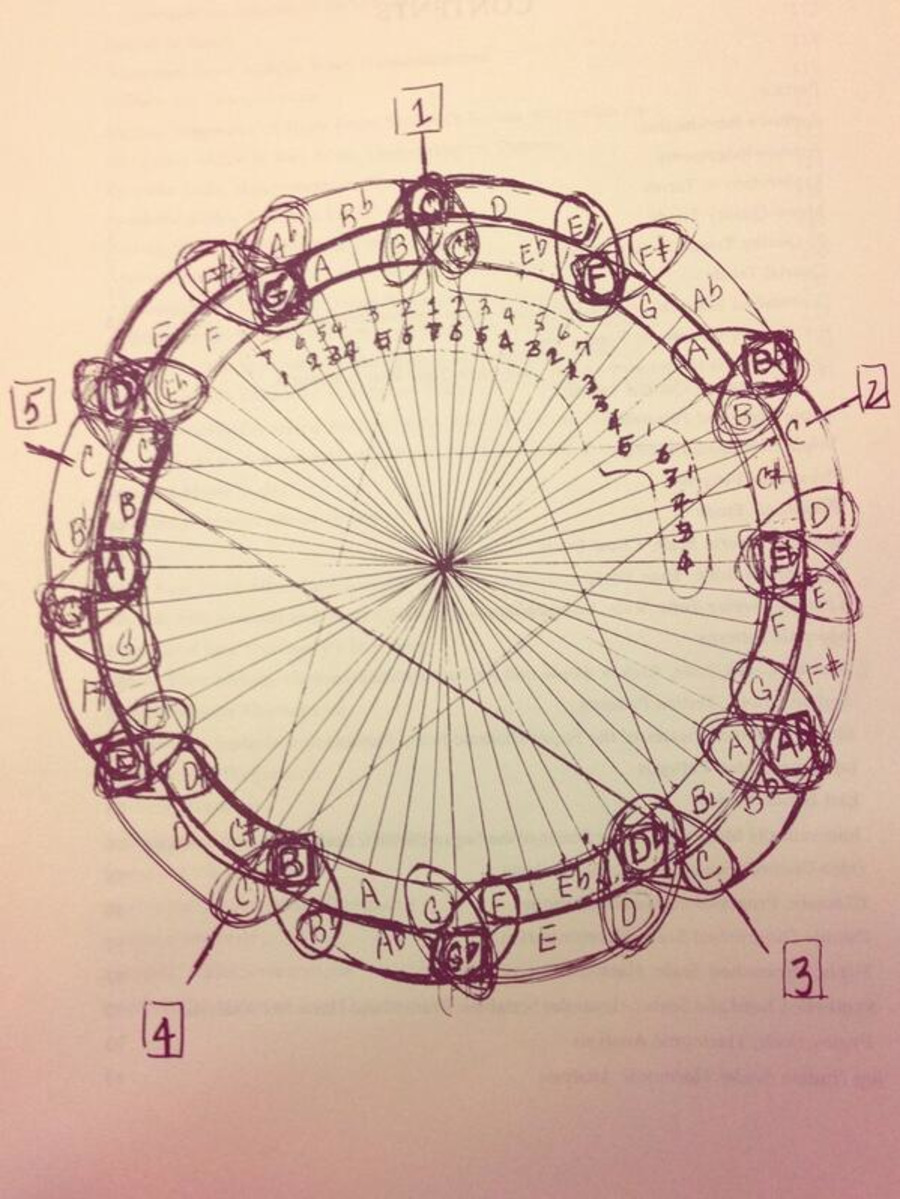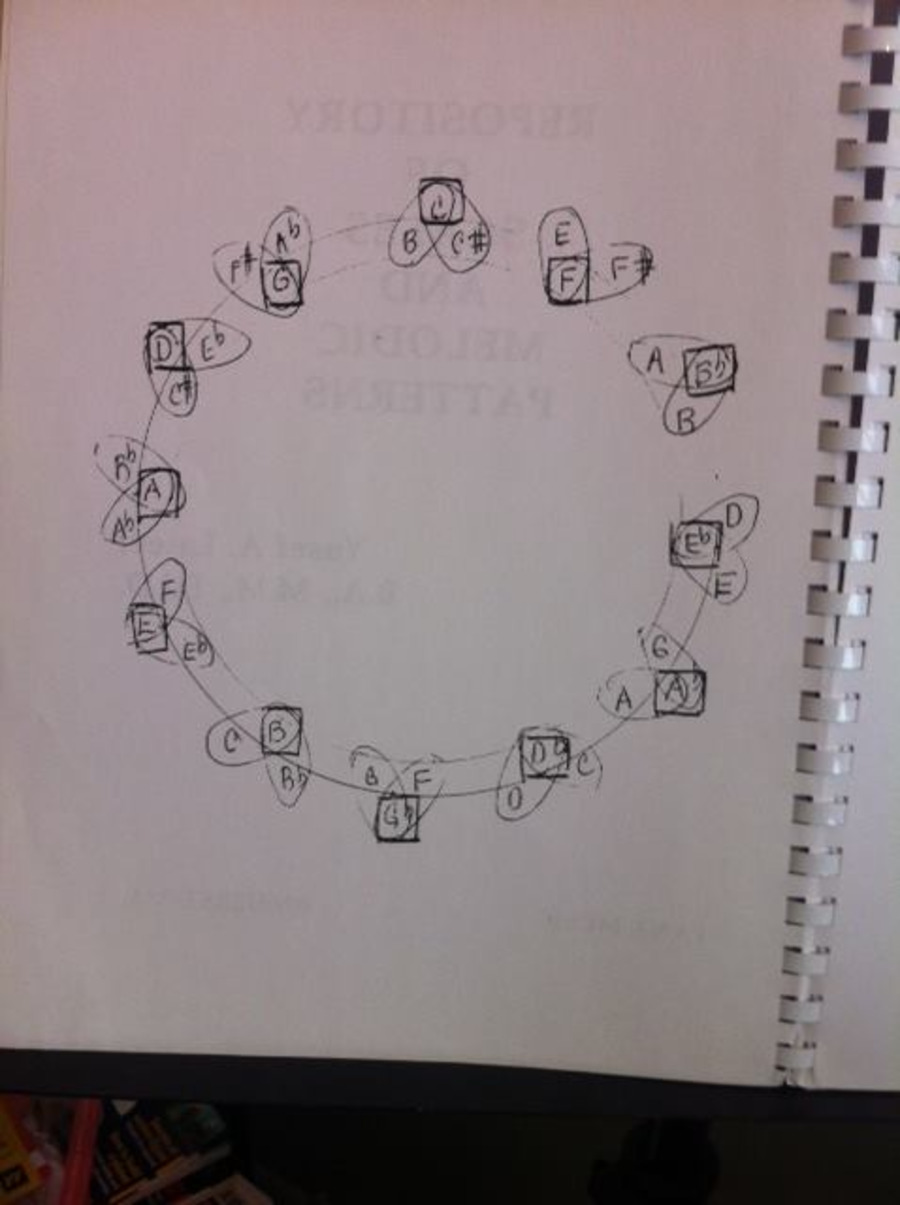I've found you've got to look back at the old things and see them in a new light. (John Coltrane, Downbeat, 1960)
Two days ago, I began looking at a diagram that John Coltrane drew and gave to Yusef Lateef. In looking at the diagram, I attempted to discard any prior "knowledge" or learning that exists for Coltrane's work, and just derive the meaning of the diagram from what is actually in the diagram itself. From this derivation, we can then connect the dots with what Coltrane played and think about his intention.
I got lots of responses to this on Facebook—with the saxophonist Ed Jones having lots of great information and insight. He wondered if Coltrane drew the chart before or after he'd read Nicolas Slominksy's Thesaurus of scales and musical patterns. Ed goes on, also providing a possible answer to a question I asked last month. All the emphases are my doing:
As to when Giant Steps was written I've read that he was working on it five years before he recorded it... that might or might not be true.
Benny Golson and Trane had the same teacher, Dennis Sandole, who also taught many others significantly Michael Brecker and Matthew Shipp.
If you look at the chart and the derived cycles and check how the voice leading works for all of the alternative subs or super-impositions (for me I prefer the term multiplicities), for example over C7 (E7 A♭7) leading to Fmaj, they produce distinct colours and melodic contours.
Which is why I have a problem with the term superimposition. It's possible to play through the cycle without really being concious of its voice leading implications: then it is a superimposition {but} I don't think Trane heard it like that. I think he heard it as part of a continuum that offered alternative sets of melodic possibilities through the harmony. [...] as a side note Benny Golson's composition Stablemates uses similar harmonic strategies to those found in Moment's Notice (chromatic ii-v's ) half step below and above the next bar... Golson must have written this prior to Coltrane joining miles in '55 as it was Trane who introduced miles to the composition... hence its inclusion in the Prestige sessions...
The senses of continuum and multiplicities are evident in the diagram. Here it is again:

And here is a picture taken by Dan Johnson of the "correction" from the same book:

Looking at the diagram again, you notice how Coltrane repeats the whole tone scales to connect the "main" pitches? For example, in the outer ring the main pitches are C, B♭, A♭, F♯, E, D, going clockwise. Each of these main pitches is connected by the reversed sequence of the same notes [so D, E, F♯, A♭, B♭, C]. The repetition of pitches gives a sense of self-similarity, which Cleveland Watkiss alluded to.
The "reversed sequence" [which is an ascending whole tone scale] is repeated five times within the diagram, and in the context of the circle this repetition forms a cycle.
The visual pattern maker Sarah Knight looked at it and clearly stated that she'd define a "grid" first, dividing the sections into the relevant equal parts. Sarah picked up on the star that highlights the five C's as the grid, which if you look at it from the perspective of the circle of fourths/fifths, is unexpected: but from a perspective of repeated whole tone scales actually makes a lot of sense [but would this be harder to draw?]. To Sarah, the anomaly in the pattern that I pointed out looked like a mistake; and according to the second picture, I now think it is.
Arun Ghosh came up with a great explanation of the "mistake", and drew a connection with Coltrane's spirituality:
I think Coltrane was using these mathematical principles to find truth; he was using geometry to create a musical system that connected with The Divine. A system that, due to its mathematical generation, was of The Divine and from The Divine. This feels quite Islamic to me, which makes a lot of sense, considering where Coltrane was at, and where he was going. For me, this also explains the "mistake"; in keeping with Islamic design, art and architecture, this has been added as a sign of respect, as only Allah is perfect.
But what Sarah also noticed was that the handwriting of the innermost numbers, the numbers marking out the C's and the note encircling lines and the inner encircled notes looks different to that of the main and subsidiary pitches. I had totally missed this. It's possible then that Lateef annotated this diagram after he received it. Lateef was exploring Islamic-based spirituality before Coltrane and fits in with Arun's idea very well.
I made some attempts yesterday at unwrapping the circle and dividing it into five sections; but I'm not finished with this yet. I do have another idea, which I think I'll do now and post in the comments when it's done. But it's thoroughly enlightening to examine this drawing in new ways.
comments (8)
Sign in to comment using almost any profile.